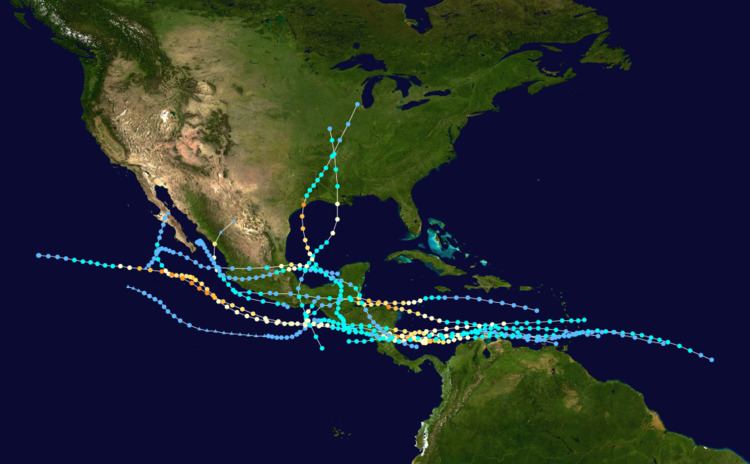An Atlantic–Pacific crossover hurricane is a tropical cyclone that develops in the Atlantic Ocean and moves into the Pacific Ocean, or vice versa. Since reliable records began in 1851, a total of seventeen tropical cyclones have done this. It is more common for the remnants of a North Atlantic hurricane to redevelop into a different storm in the Pacific; in such a scenario, they are not considered the same system.
Note: Information is mostly provided by the Atlantic best track.
There were several other tropical cyclones that formed in one basin, dissipated, and re-developed. In addition, there were tropical cyclones that developed and entered another basin briefly or at a weak intensity, however, they were not recognized as an Atlantic-Pacific crossover hurricane. In chronological order from most recent to earliest, they are:
The remnants of Hurricane Janet in 1955 later led to the formation of an unnamed tropical storm in the East Pacific on October 1; the newly generated tropical cyclone later brought rains to the southwestern United States.
Hurricane Hattie in 1961 developed in the Atlantic, and crossed into the Pacific, eventually re-developing into Tropical Storm Simone in the Pacific. It also appeared that remnants of Simone re-emerged into the Atlantic basin to develop into Tropical Storm Inga. However, the viewpoint of U.S. Weather Bureau Office was that "the remnants of Hattie developed into neither Simone nor Inga.
Tropical Storm Chloe made landfall in the Yucatan Peninsula and dissipated soon after. Its remnants continued into the Eastern Pacific and developed into Hurricane Lily, which made landfall in southwest Mexico.
Hurricane Cosme in 1989 crossed from the Pacific and dissipated over northern Mexico. Its remnants contributed to the development of Tropical Storm Allison in the Atlantic.
Tropical Storm Bret from 1993 retained its circulation and was designated Tropical Depression Eight-E upon reaching the Pacific. The depression dissipated, reorganized, and became Hurricane Greg.
Tropical Depression Nine in 2001 made landfall in Nicaragua and degenerated into a tropical wave. The wave later regenerated into a tropical depression that became Hurricane Juliette.
Hurricane Iris of 2001 in the Atlantic Ocean triggered the formation of Tropical Storm Manuel in the Pacific.
Tropical Storm Earl in 2004 dissipated in the southeast Caribbean Sea, but regenerated into Hurricane Frank in the East Pacific.
Tropical Storm Alma of 2008 formed off of the West Coast of Costa Rica, made landfall in Nicaragua with speeds up to 100 kilometres per hour (62 mph). The storm soon dissipated. A day later the storm's remnants after encountering a pair of two tropical waves regenerated on Nicaragua's east coast into Tropical Storm Arthur with sustained winds of 75 km/h (47 mph) and again made landfall in Nicaragua. It is not considered as crossover over as the initial storm had dissipated.
Hurricane Ernesto of 2012 developed near the Lesser Antilles. The system weakened to a low-pressure area in Mexico and its remnants moved into the eastern Pacific and developed into Tropical Storm Hector.
Hurricane Barbara of 2013 made landfall in southwest Mexico and dissipated before reaching the Gulf of Mexico. The remnants of Barbara and a cyclonic gyre led to the formation of a broad area of low pressure, which later became Tropical Storm Andrea over the central Gulf of Mexico.
Tropical Storm Trudy of 2014 made landfall in southern Mexico, its remnants emerged into the Bay of Campeche and subsequently developed into Tropical Storm Hanna in the Atlantic.
The remnant moisture from Hurricane Earl of 2016 interacted with a disturbance on the Pacific coast of Mexico, which contributed to the formation of Tropical Storm Javier in the eastern Pacific.
Prior to 2000, storms were re-named after crossing from the Gulf of Mexico into the Eastern Pacific. At the 22nd hurricane committee in 2000 it was decided that tropical cyclones that moved from the Atlantic to the Eastern Pacific basin and vice versa would no longer be renamed. Hurricane Otto in 2016 was the first to crossover to the Pacific under this rule.

